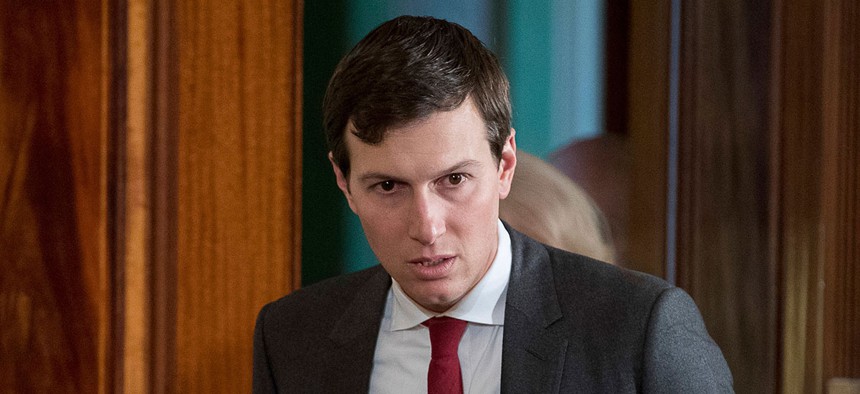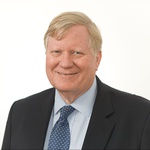
Andrew Harnik/AP
Kushner’s Curious Plan for a Back Channel
Secret contacts are as old as the Republic, but his suggested use of Russian communications links mystifies diplomats and intelligence analysts.
Diplomatic back channels, far from being invented by Donald Trump or his son-in-law Jared Kushner, have been an accepted fixture in almost every presidency since George Washington, most famously at the time of the Cuban Missile Crisis in 1962 when President Kennedy’s brother, Robert F. Kennedy, was more engaged than his secretary of State.
President Washington encouraged Alexander Hamilton to hide his talks with a British general from Secretary of State Thomas Jefferson. Washington knew Jefferson was hostile to normalized relations with the former enemy and kept him in the dark until formal relations were opened in 1791, according to Washington biographer Ron Chernow. That proved more demonstrably successful than Kennedy’s 171 years later.
Even before the Soviet missiles were spotted in Cuba, Attorney General Kennedy had developed a close relationship with Georgi Bolshakov, a Soviet GRU agent he had invited to his home, met with almost three dozen times, and taken messages from for his brother, the president. But, as Evan Thomas notes in his 2000 biography Robert Kennedy. His Life, Bolshakov had misled him about the missiles, insisting they were only defensive. Kennedy soon learned that the Kremlin had intentionally kept Bolshakov in the dark so he could mislead Kennedy.
“Bolshakov’s unwitting deception illustrates the drawbacks of operating through go-betweens … and back channels,” wrote Thomas. It also explained why, in the midst of the missile crisis, Kennedy made more use of another back channel—Soviet ambassador Anatoly Dobrynin. A key moment was when President Kennedy had his brother meet secretly at the Justice Department with the ambassador to send a message that the United States was willing to remove its missiles from Turkey to defuse the crisis.
The long history of back channels winds from Washington through Franklin Roosevelt’s use of Harry Hopkins to establish diplomatic relations with the Soviet Union, to President Kennedy’s use of his brother, Richard M. Nixon’s use of Henry Kissinger to forge an arms-limitation treaty with the Soviets and the opening to China, and Barack Obama’s work with the pope to normalize relations with Cuba in 2014.
“Back channels are as old as diplomacy itself,” said Richard A. Moss, an associate research professor at the Naval War College’s Center for Naval Warfare Studies. “Back channels are an essential tool in the diplomatic tool box. They are a very effective tool when wielded properly.”
The problem for Kushner—and the likely reason his back channel is subject to more second-guessing than previous secret communications—is that he proved himself no Alexander Hamilton in his dealings with Russian officials during the transition. While veteran diplomats were unconcerned by his meetings and viewed the president-elect as being well within his rights to open a dialogue, many were mystified by the steps that Kushner allegedly took to shield his conversations from U.S. counterintelligence officials.
The meeting, first reported by The Washington Post last week, brought Ambassador Sergey Kislyak to Trump Tower in New York on either Dec. 1 or 2, according to intercepts of Russian communications cited by the Post. At the meeting, which also included Trump’s first national security adviser, Michael Flynn, the men discussed Kushner using Russian diplomatic facilities, presumably to keep their talks from being monitored by U.S. counterintelligence.
Moss is the coauthor of a new book, Nixon’s Back Channel to Moscow: Confidential Diplomacy and Détente. He noted that there is ample precedent for such back channels in presidential transitions, citing Nixon’s use of Kissinger to signal the Kremlin in 1968 that he was ready to work for better relations. But he finds no precedent for Kushner’s offer to use highly secure Russian facilities, recalling that Kissinger made a point of keeping the FBI aware of what he was doing. It was the State Department that Nixon wanted shut out, particularly on China.
“The possible use of Russian secured communications, that just looks terrible,” Moss told National Journal. “It looks like it was designed to circumvent legitimate U.S. counterintelligence monitoring.”
Cuba may have been the cause of more back channel-subterfuge than almost any other foreign hot spot. In Back Channel to Cuba: The Hidden History of Negotiations Between Washington and Havana, author Peter Kornbluh examines 50 years of behind-the-scenes and unofficial talks to free prisoners and inch the United States and Cuba toward reconciliation.
Separate from those discussions, the meetings on the Cuban Missile Crisis were some of the most intense. On the day before Robert Kennedy met with the ambassador, the Soviets set up a meeting between ABC newsman John Scali and the embassy counselor, Aleksandr Fomin, who was the chief Soviet intelligence operative in the United States. Fomin and Scali discussed the crisis at the Occidental Restaurant, a coffee shop at what is now the Capital Hilton, and at the Yenching Palace restaurant on Connecticut Avenue. Scali, who later would become U.S. ambassador to the United Nations, served as a courier between the two sides until the crisis was resolved.
Kornbluh sees differences in what is happening today. What sets the Kushner-Flynn contact apart from previous back channels, he said, is not only the suggested use of Russian facilities, but also that it came at a time when the Trump campaign’s links to Russian interests were a source of controversy.
“It’s not the issue of back channels,” he told National Journal. “It’s the issue of when they’re done and what they’re being done for.”
Kornbluh, senior analyst at the National Security Archive at George Washington University, added, “If they use the Russian facilities, that would mean that the Russians really would have great leverage knowing what was said when nobody else knew what was said. This is beyond peculiar.”
The same concern was expressed by Michael J. Morell, the former acting director and deputy director of the CIA. In a Q&A this week with the security site The Cipher Brief, Morell urged people not to overreact to news of the meeting, stating his lack of confidence in The Washington Post’s sourcing and stressing that too few facts are known at this point. Morell, though, shares the concerns of other analysts like Moss and Kornbluh.
“Why the request for the use of the Russian embassy’s secure communications?” he asked. “There are potential answers to those questions that would leave me saying, ‘OK, I understand. It was not smart to ask, but I get it and it is OK.” He added, “And there are potential answers to those questions that would leave me saying, ‘Put that at the top of the FBI’s list’.”
Moss endorses Morell’s caution and his expectation that the talk of using Russian communications will become the focus of the investigation. “There may be perfectly legitimate reasons for doing that. There may be nefarious reasons for doing that,” he said. “The only way we’re going to find out is if it is investigated.”
NEXT STORY: Summer Makes You More Productive







